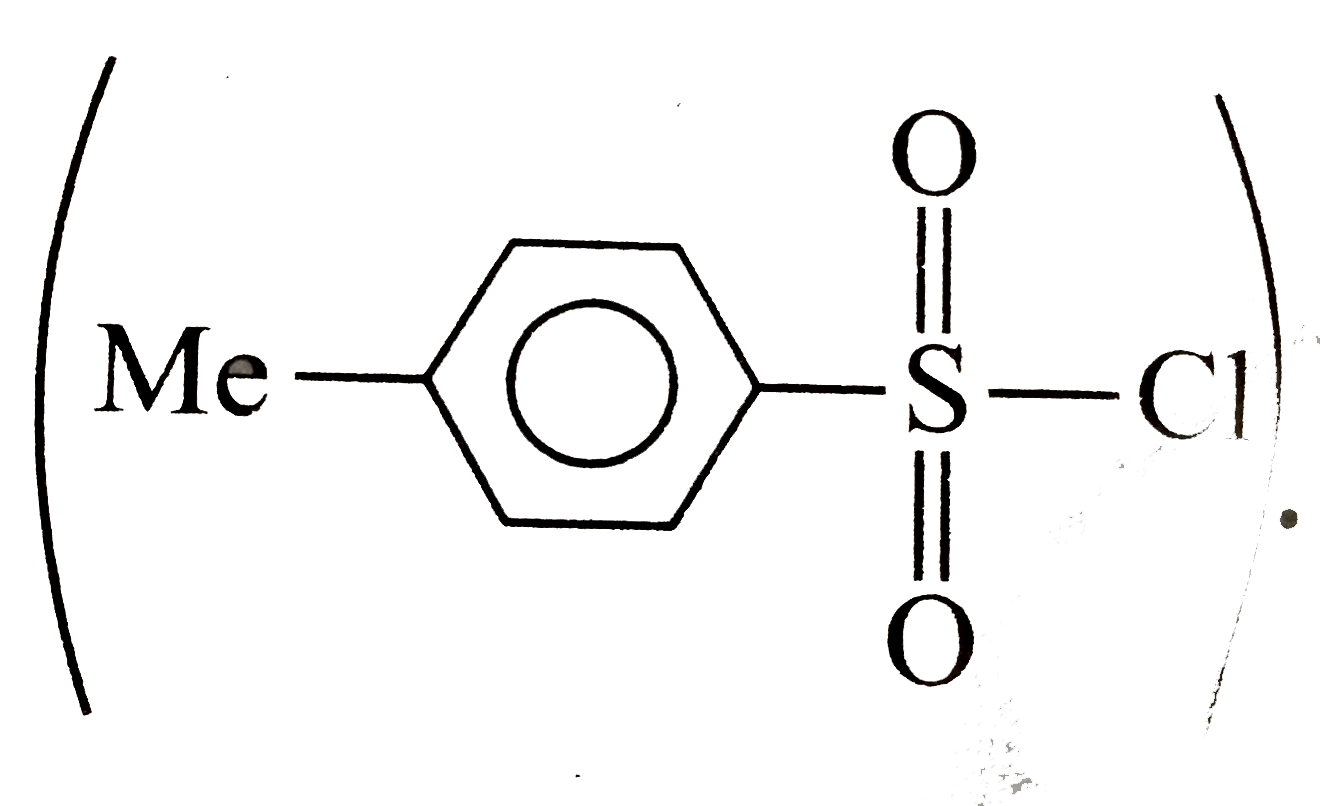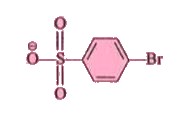The leaving group is that functional group which is ejected with ¯e,s of the σ -bond in a reaction. Better the leaving group, faster is the reaction. The relative leaving ability of the leaving group X in (R−X) is increased by :
(i) The polarisability of (R−X) bond.
(ii) The stability of XӨ.
(iii) The degree of stabilisation through solvation of X.
(iv) The strength of (R−X) bond.
The leaving group tendency is also called fugacity.
Which statement is correct ?
EtOӨ is a strong base and therefore a good leaving group.
The amine group in ArNH2 is converted into a good leaving group be reacting ArNH2 with NaNO2+HCl at 0∘C.
The (OH) group is converted into a good leaving group by reacting alcohols with TsCl (p-toluene sulphonyl chloride) 
The amine group in RNH2 is converted into leaving group by reacting RNH2 with NaNO2+HCl at 0∘C.
The correct Answer is:C
To determine which statements regarding leaving groups are correct, we will analyze each statement one by one.
1. Statement A: "Ethoxide ion is a strong base and therefore a strong leaving group."
- Analysis: A good leaving group must be a weak base. Ethoxide ion (C2H5O-) is a strong base, which means it is not a good leaving group because it would tend to re-attack the substrate rather than leave. Therefore, this statement is incorrect.
2. Statement B: "The amine group in ArNH2 is converted into a good leaving group on reacting ArNH2 with NaNO2 at Cl at 0°C."
- Analysis: When aniline (ArNH2) reacts with sodium nitrite (NaNO2) in the presence of hydrochloric acid at low temperatures, it forms diazonium chloride (ArN2+Cl-). The leaving group here is the nitrogen gas (N2), which is a very stable and weak base. Thus, this statement is correct.
3. Statement C: "The OH group is converted into a good leaving group by reacting alcohol with tosyl chloride."
- Analysis: Alcohols (R-OH) are generally poor leaving groups. However, when they react with tosyl chloride (TsCl), they form tosylate (R-OTs), which is a much better leaving group. This is because the tosylate ion is more stable than the hydroxide ion. Therefore, this statement is correct.
4. Statement D: "The amine group in RNH2 is converted into a good leaving group by reacting amine with NaNO2 HCl at 0°C."
- Analysis: Similar to statement B, the reaction of RNH2 with NaNO2 and HCl leads to the formation of a diazonium ion (RN2+). The leaving group here is again nitrogen gas (N2), which is stable and a good leaving group. Thus, this statement is correct.
Conclusion:
The correct statements are B, C, and D. Therefore, the answer is BCD.
- Analysis: A good leaving group must be a weak base. Ethoxide ion (C2H5O-) is a strong base, which means it is not a good leaving group because it would tend to re-attack the substrate rather than leave. Therefore, this statement is incorrect.
- Analysis: When aniline (ArNH2) reacts with sodium nitrite (NaNO2) in the presence of hydrochloric acid at low temperatures, it forms diazonium chloride (ArN2+Cl-). The leaving group here is the nitrogen gas (N2), which is a very stable and weak base. Thus, this statement is correct.
- Analysis: Alcohols (R-OH) are generally poor leaving groups. However, when they react with tosyl chloride (TsCl), they form tosylate (R-OTs), which is a much better leaving group. This is because the tosylate ion is more stable than the hydroxide ion. Therefore, this statement is correct.
- Analysis: Similar to statement B, the reaction of RNH2 with NaNO2 and HCl leads to the formation of a diazonium ion (RN2+). The leaving group here is again nitrogen gas (N2), which is stable and a good leaving group. Thus, this statement is correct.
The correct statements are B, C, and D. Therefore, the answer is BCD.
Topper's Solved these Questions
- ORGANIC REACTION MECHANISMBOOK - CENGAGE CHEMISTRY ENGLISHCHAPTER - ORGANIC REACTION MECHANISMEXERCISE - Multiple Correct
30 Videos
- ORGANIC REACTION MECHANISMBOOK - CENGAGE CHEMISTRY ENGLISHCHAPTER - ORGANIC REACTION MECHANISMEXERCISE - Single correct
43 Videos
- ORGANIC REACTION MECHANISMBOOK - CENGAGE CHEMISTRY ENGLISHCHAPTER - ORGANIC REACTION MECHANISMEXERCISE - Subjective
19 Videos
- NCERT BASED EXERCISEBOOK - CENGAGE CHEMISTRY ENGLISHCHAPTER - NCERT BASED EXERCISEEXERCISE - Chemical Equilibrium
73 Videos
- P-BLOCK GROUP 13 - BORON FAMILYBOOK - CENGAGE CHEMISTRY ENGLISHCHAPTER - P-BLOCK GROUP 13 - BORON FAMILYEXERCISE - Exercise Archives (Subjecive)
9 Videos
Similar Questions
The leaving group is that functional group which is ejected with ¯e,s of the σ -bond in a reaction. Better the leaving group, faster is the reaction. The relative leaving ability of the leaving group X in (R−X) is increased by :
(i) The polarisability of (R−X) bond.
(ii) The stability of XӨ.
(iii) The degree of stabilisation through solvation of X.
(iv) The strength of (R−X) bond.
The leaving group tendency is also called fugacity.
Which of the following undergoes SN reaction easily ?
View SolutionThe leaving group is that functional group which is ejected with ¯e,s of the σ -bond in a reaction. Better the leaving group, faster is the reaction. The relative leaving ability of the leaving group X in (R−X) is increased by :
(i) The polarisability of (R−X) bond.
(ii) The stability of XӨ.
(iii) The degree of stabilisation through solvation of X.
(iv) The strength of (R−X) bond.
The leaving group tendency is also called fugacity.
Which of the following is the wrong order of fugacity ?
View Solution
Knowledge Check
Correct order of leaving group tendency is :
AI−>Br−>Cl−>F−BF−>Cl−>Br−>I−CCl−>F−>Br−>I−DI−>Cl−>Br−>F−Which is the best leaving group ?
A−⊕N≡NBOH−CNH−2DCH3COO−Which of the following are better leaving group than
 AΘO−O∣∣S∣∣O−CF3B
AΘO−O∣∣S∣∣O−CF3B C−⊕N≡ND−Fө
C−⊕N≡ND−Fө
The leaving group is that functional group which is ejected with ¯e,s of the σ -bond in a reaction. Better the leaving group, faster is the reaction. The relative leaving ability of the leaving group X in (R−X) is increased by :
(i) The polarisability of (R−X) bond.
(ii) The stability of XӨ.
(iii) The degree of stabilisation through solvation of X.
(iv) The strength of (R−X) bond.
The leaving group tendency is also called fugacity.
Which one of the followingd has the highest fugacity ?
View SolutionThe correct order of the ability of the leaving group is
View SolutionThe order of leaving group ability is :
View SolutionDuring SN1 reactions, the leaving group leaves the molecule before the incoming group is attached to the molecule.
View SolutionMention the functional group of amino acids involved in the formation of a peptide bond.
View Solution
